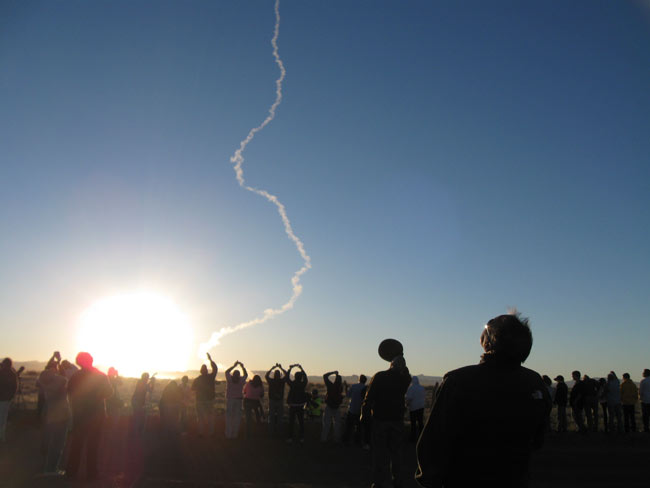Suborbital Rocket Launches With Student Experiments, Human Ashes Onboard

LAS CRUCES, New Mexico ? A small rocket carrying studentexperiments and the cremated remains of 21 people successfully launched on amemorial suborbital spaceflight Tuesday and landed smoothly in New Mexico.
The early morning launch of the UP Aerospace SpaceLoft XLrocket was staged from SpaceportAmerica ? a remote site outside Upham, New Mexico that is nowa scene of fast-paced construction. Spaceport America is tagged as the firstpurpose-built commercial space facility.
The mission was primarily aimed at flying a suite ofstudent-built experiments dubbed the New Mexico Second Annual Education Launch.The project, sponsored by the New Mexico Space Grant Consortium at New MexicoState University, included high school, college and university investigationsfrom across the state.
Loved ones onboard
The launch carried capsules packed with crematedremains from the United States, China, Taiwan, and Great Britain. After theflight the containers were recovered and will be returned to the families of?Pioneer Flight? participants.
There were 21 participants on this mission, noted CharlesChafer, chief executive officer of Celestis,Incorporated of Houston. Celestis helps families honor the memory of loved onesthrough unique, post-cremation memorial spaceflights.
?We are very pleased to share today?s success with ourfamilies and partners at New Mexico Space Grant Consortium and UP Aerospace andlook forward to many more successful missions in the future,? Chafer toldSPACE.com. ?The Celestis service remains the most compelling memorial serviceon or off the planet,? he added.
Get the Space.com Newsletter
Breaking space news, the latest updates on rocket launches, skywatching events and more!
The flight was an Earth Rise (suborbital) mission offered byCelestis. The group worked with the primary sponsor of the mission -- the NewMexico Space Grant Consortium -- by providing matching funds that assistedstudents to launch their experiments into space.
High-speed trajectory
The rocket launch showcased a new era of access to space forstudent experiments.
?Today is all about what SpaceportAmerica was created for?about education, it?s about jobs, it is aboutcareers and new opportunities in New Mexico,? said Rick Homans, Board Chairmanof the New Mexico Spaceport Authority shortly after the rocket?s launch andpayload landing.
?I?m speechless. It was a perfect flight,? said JerryLarson, president of Colorado-based UP Aerospace. He told SPACE.com that themission was a total success from liftoff to touchdown, landing only two milesfrom the target 35 miles away on White Sands Missile Range.
Lockheed Martin provided a pre-launch mission assurancereview of the booster, appraising the readiness for flight of the entire rocket- from avionics to parachute deployments.
In a post-launch review, Larson said the rocket reached 70miles altitude, hitting a top velocity of Mach 5.5 ? five and a half times thespeed of sound. ?So she was really cooking,? Larson added.
The booster?s solid rocket motor burned for 12 seconds on ahigh-speed trajectory followed by a long coast period. A parachute system ledto touchdown of the payload at nearby White Sands Missile Range at a very modest10 miles per hour.
?It was a nice soft landing. Your payloads are going to beperfect,? Larson advised the students during his debriefing remarks.
Student access to space
??Today?s launch is confirmation to New Mexico?s studentsand the rest of the world that we are capable of delivering the goods when itcomes to scientific development, aerospace research and intellectual capital,?said Pat Hynes, Director of the New Mexico Space Grant Consortium in a pressstatement.
Hynes said that the launch was dedicated to the memory ofDebbie Prell, a Farmington, New Mexico science and technology teacher who diedof breast cancer in 2005.
Launch participants wore special pink shirts in memory ofPrell. The specially-designed T-shirts read: ?Rocket Scientists are ToughEnough to Wear Pink.?
Leonard David has been reporting on the space industryfor more than five decades. He is past editor-in-chief of the National SpaceSociety's Ad Astra and Space World magazines and has written for SPACE.comsince 1999.
- PrivateRocket Launches Ashes of Star Trek's Scotty, Astronaut to Suborbital Space
- Images - Commercial Spaceflight: Part 1, Part 2
- America's1st Commercial Spaceport Blooms in the Desert
Join our Space Forums to keep talking space on the latest missions, night sky and more! And if you have a news tip, correction or comment, let us know at: community@space.com.

Leonard David is an award-winning space journalist who has been reporting on space activities for more than 50 years. Currently writing as Space.com's Space Insider Columnist among his other projects, Leonard has authored numerous books on space exploration, Mars missions and more, with his latest being "Moon Rush: The New Space Race" published in 2019 by National Geographic. He also wrote "Mars: Our Future on the Red Planet" released in 2016 by National Geographic. Leonard has served as a correspondent for SpaceNews, Scientific American and Aerospace America for the AIAA. He has received many awards, including the first Ordway Award for Sustained Excellence in Spaceflight History in 2015 at the AAS Wernher von Braun Memorial Symposium. You can find out Leonard's latest project at his website and on Twitter.









